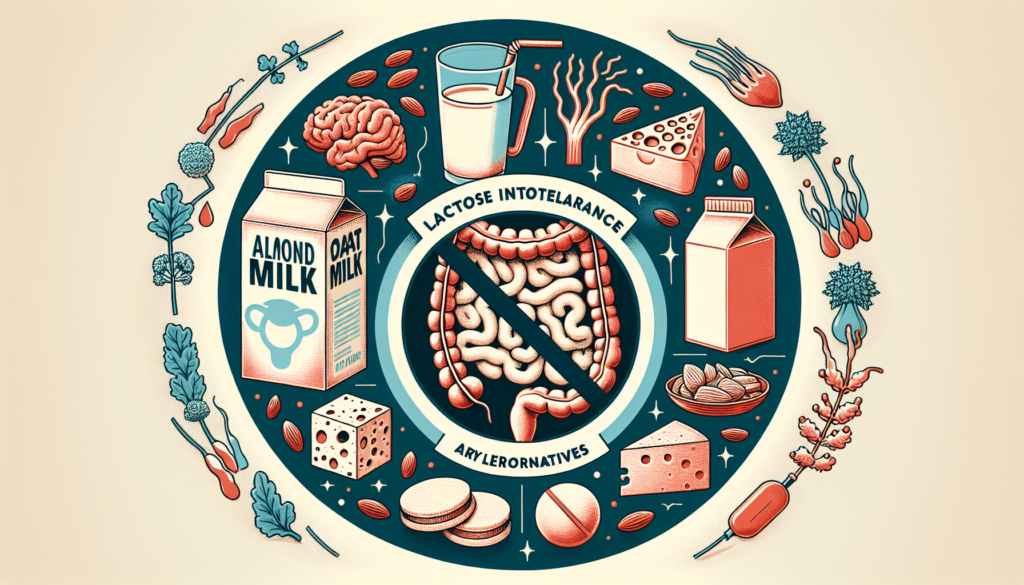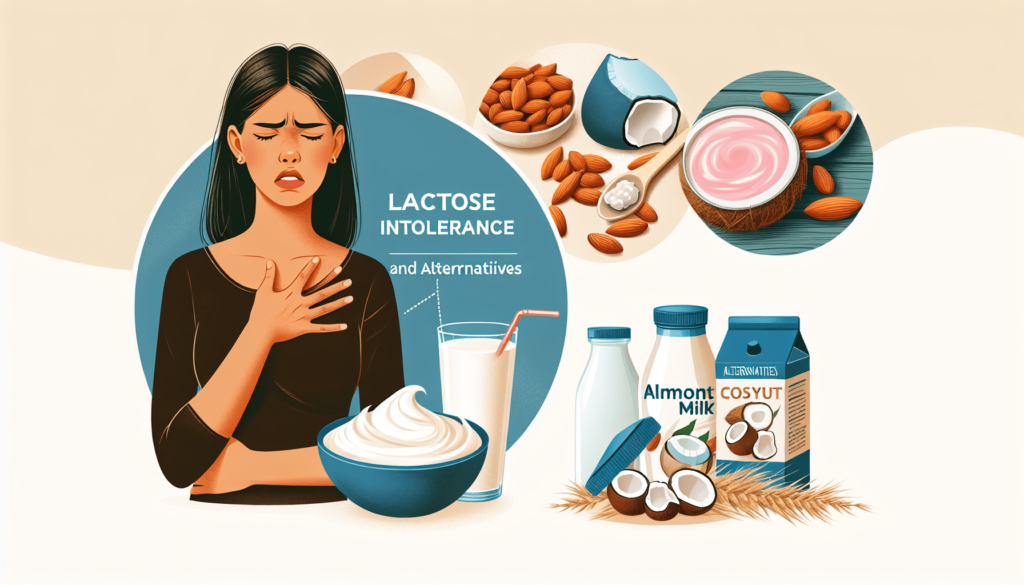If you’ve ever experienced discomfort after consuming dairy products, then you may be familiar with lactose intolerance. In this article, we will explore what lactose intolerance is and how it affects our bodies. With a focus on dairy alternatives, we will also provide valuable insights on the various non-dairy options available to help you enjoy your favorite foods without compromising your digestive system. So, let’s dive in and discover the key information you need to navigate lactose intolerance and make informed choices for your overall well-being.
What is Lactose Intolerance?
Lactose intolerance is a common digestive disorder where the body is unable to fully digest lactose, a natural sugar found in milk and other dairy products. It occurs when the body doesn’t produce enough lactase, the enzyme responsible for breaking down lactose. As a result, undigested lactose reaches the colon, causing various symptoms.
Definition of lactose intolerance
Lactose intolerance refers to the inability to digest lactose due to a deficiency of the enzyme lactase. Lactase is necessary to break down lactose into glucose and galactose, which can then be absorbed and used by the body. When lactose remains undigested, it can lead to various digestive discomforts.

Causes of lactose intolerance
There are different causes of lactose intolerance. Primary lactose intolerance is the most common and is usually genetic. It occurs when the body naturally decreases lactase production after childhood. Secondary lactose intolerance can be caused by certain underlying conditions, such as gastrointestinal diseases or injuries. Additionally, some individuals may experience temporary lactose intolerance after an illness or surgery.
Symptoms of lactose intolerance
The symptoms of lactose intolerance can vary from person to person and depend on the amount of lactose consumed. Common symptoms include bloating, cramps, diarrhea, flatulence, and nausea. These symptoms usually appear within a few hours after consuming dairy products.

Understanding Dairy Alternatives
Dairy alternatives, also known as non-dairy or plant-based alternatives, are products that are designed to mimic the taste and texture of dairy products without containing lactose. They are made from various plant sources, such as soy, almonds, coconut, oats, and rice. These alternatives provide an excellent option for individuals with lactose intolerance or those who choose to follow a vegan or dairy-free lifestyle.
Types of dairy alternatives
There are several types of dairy alternatives available to individuals with lactose intolerance. Soy milk is made from soybeans and has a creamy texture similar to cow’s milk. Almond milk is made from almonds and has a slightly nutty flavor. Coconut and oat milk offer a rich and creamy consistency, while rice milk provides a lighter and more watery texture. Each type of dairy alternative has its unique taste and nutritional profile, allowing individuals to choose based on personal preferences and dietary needs.

Nutritional value of dairy alternatives
Dairy alternatives can be a valuable addition to a lactose-free diet as they offer several essential nutrients. Many dairy alternatives are fortified with calcium, vitamin D, and other minerals to make up for the nutrients found in cow’s milk. Furthermore, they can be good sources of plant-based protein, healthy fats, and vitamins such as vitamin E and B vitamins. However, it is important to read labels and choose fortified options to ensure adequate nutrition.
Popular dairy alternative products
The market for dairy alternatives has grown rapidly in recent years, and there is now a wide range of products available. Besides various plant-based milk options, there are dairy-free yogurts, cheeses, ice creams, and butter substitutes. These products often provide a similar taste and texture to their dairy counterparts, allowing individuals with lactose intolerance to enjoy their favorite foods without discomfort.

Benefits of Dairy Alternatives for Lactose Intolerant Individuals
Relief from digestive discomfort
One of the significant benefits of dairy alternatives for lactose intolerant individuals is relief from digestive discomfort. By consuming non-dairy products, such as plant-based milk or cheese substitutes, individuals can avoid the symptoms associated with lactose intolerance, such as bloating and diarrhea.
Improved nutrient absorption
Dairy alternatives can also lead to improved nutrient absorption for individuals with lactose intolerance. Since they do not contain lactose, there is no risk of undigested lactose reaching the colon and interfering with nutrient absorption. This ensures that the body can effectively absorb the essential nutrients present in the alternative products.
Diverse food options
Another advantage of dairy alternatives is the opportunity to explore diverse food options. With the wide range of non-dairy products available, individuals can still enjoy creamy soups, smoothies, desserts, and other dishes that traditionally use milk or dairy ingredients. This diversity allows individuals to maintain a varied and enjoyable diet without feeling limited by their lactose intolerance.
Choosing the Right Dairy Alternatives
Identifying lactose-free or low-lactose products
When choosing dairy alternatives, it is essential to identify products that are specifically labeled as lactose-free or low-lactose. These products are formulated to remove or reduce lactose, making them suitable for individuals with lactose intolerance. Reading product labels carefully and looking for these designations can ensure that you are making the right choices for your dietary needs.
Reading ingredient labels
In addition to checking for lactose content, it is important to read the ingredient labels of dairy alternatives to ensure that they meet your dietary requirements. Some dairy alternatives may contain other allergens or undesirable additives, so being aware of the ingredients is crucial. Opting for products with simple and natural ingredients is generally recommended.
Considering taste and texture
Choosing the right dairy alternative goes beyond selecting based on nutritional content and ingredient list. The taste and texture of the product also play a significant role in your overall satisfaction. It is recommended to try different brands and flavors to find the ones that best suit your preferences. Experimenting and exploring various options can help you discover new favorites.
Common Dairy Alternative Options
Soy milk
Soy milk is one of the most popular dairy alternatives and has been on the market for a long time. It has a mild and slightly sweet taste, making it a versatile option for various recipes and beverages. Soy milk is a good source of protein and other essential nutrients like calcium and vitamin D. Its creamy texture makes it suitable for use in coffee, baking, and cooking.
Almond milk
Almond milk is made from ground almonds and water, offering a delicate and slightly nutty flavor. It is naturally low in calories and fat, making it a popular choice for individuals looking to reduce their calorie intake. Almond milk is often used in smoothies, cereal, or enjoyed on its own. However, it should be noted that almond milk may not be suitable for individuals with nut allergies.
Coconut milk
Coconut milk is derived from the meat of mature coconuts and has a rich and creamy texture with a subtle coconut flavor. It is a popular choice for curries, desserts, and creamy sauces. Coconut milk contains healthy fats and can add a tropical twist to your recipes. However, it is higher in calories compared to other dairy alternatives, so moderation is key.
Oat milk
Oat milk is made from a blend of oats and water, providing a smooth and creamy texture. It has a mild and slightly sweet taste, making it a versatile option for various recipes. Oat milk is a good source of fiber and contains beta-glucans, which have been associated with heart health benefits. It is commonly used in coffee, cereal, and baking.
Rice milk
Rice milk is made from milled rice and water, resulting in a thin and slightly sweet alternative to cow’s milk. It has a milder taste compared to other dairy alternatives and is often used in recipes that require a neutral flavor. Rice milk is naturally cholesterol-free and low in fat, but it is also lower in protein compared to other options.
Cooking and Baking with Dairy Alternatives
Substituting dairy in recipes
Cooking and baking with dairy alternatives can be a straightforward process with a few adjustments. In most recipes, dairy alternatives can be used as a one-to-one substitute for milk. This applies to both liquid dairy alternatives, such as soy or almond milk, and thicker options like coconut milk or oat milk. When replacing other dairy products like butter or cream, alternative options specifically made for cooking and baking should be used.
Tips for successful cooking and baking
When using dairy alternatives in cooking and baking, it is essential to consider the specific properties of the non-dairy product. Some alternatives, like soy milk or oat milk, can handle high heat and work well in baking or simmering. Others, like almond milk or rice milk, may be better suited for cold recipes or as a base for smoothies. Experimenting and adapting recipes to find what works best for you is part of the fun.
Adjusting for flavor and texture
It is important to note that dairy alternatives can have different flavors and textures compared to their dairy counterparts. This can affect the overall taste and consistency of the finished dish. Adjusting the seasoning, sweetness, or thickness of a recipe may be necessary to achieve the desired flavor and texture. Adding a touch of vanilla extract, sugar, or cornstarch can help achieve the desired results.
Maintaining a Balanced Diet without Dairy
Getting essential nutrients
While dairy alternatives can be a valuable part of a lactose-free diet, it is crucial to ensure that you are still receiving essential nutrients. Incorporating a variety of fruits, vegetables, whole grains, legumes, and other plant-based protein sources into your diet can provide a wide range of vitamins, minerals, and antioxidants. It is also important to seek out alternative sources of nutrients typically found in dairy products, such as calcium, vitamin D, and protein.
Calcium and vitamin D sources
Calcium and vitamin D are essential for maintaining healthy bones and teeth. While dairy products are excellent sources of these nutrients, they can also be obtained from various non-dairy sources. Leafy green vegetables, such as kale and broccoli, are rich in calcium. Fortified foods, such as non-dairy milks and cereals, can provide additional sources of both calcium and vitamin D. Sun exposure is also a natural source of vitamin D.
Protein alternatives
Protein is an important macronutrient that plays a role in many bodily functions. While dairy products are traditionally known for their protein content, there are numerous plant-based protein sources available. Legumes, such as lentils and chickpeas, soy products, quinoa, tofu, and tempeh are all excellent sources of plant-based protein. By incorporating these protein alternatives into your diet, you can maintain a balanced intake of this vital nutrient.
Potential Downsides and Considerations
Allergies to dairy alternatives
While dairy alternatives can provide relief for individuals with lactose intolerance, it is important to note that some individuals may have allergies or sensitivities to these products. Common allergens include nuts, soy, and gluten, which are often found in dairy alternatives. If you have known allergies or sensitivities, it is essential to read labels carefully and choose alternatives that do not contain these allergens.
Added sugars in some products
It is also important to be mindful of added sugars when choosing dairy alternatives. Some flavored or sweetened products can contain high amounts of added sugars, which may have implications for overall health and wellbeing. Opting for unsweetened or lightly sweetened varieties can help reduce the intake of added sugars. Checking the nutrition labels and comparing products can ensure that you are making the healthiest choices.
Cost and availability
Another consideration when using dairy alternatives is the cost and availability of these products. Depending on your location, some dairy alternatives may be more expensive or harder to find than others. It may require some research and exploration to find the most affordable and accessible options in your area. Planning ahead and exploring different stores and online platforms can help you discover the best options for your needs.
Consulting a Healthcare Professional
Individualized dietary recommendations
If you are unsure about incorporating dairy alternatives into your diet or have concerns about meeting your nutritional needs, it is best to consult a healthcare professional. A registered dietitian or healthcare provider can provide individualized dietary recommendations based on your specific needs, preferences, and health conditions. This personalized guidance can help ensure that you are making the best choices for your overall health and wellbeing.
Additional tests for lactose intolerance
In some cases, healthcare professionals may recommend additional tests to confirm the diagnosis of lactose intolerance or evaluate its severity. These tests may include lactose tolerance tests or hydrogen breath tests, which can measure how your body reacts to lactose. These tests can provide valuable information and help guide dietary decisions and management strategies.
Monitoring nutritional status
Regular monitoring of your nutritional status is essential when following a lactose-free diet or using dairy alternatives. Nutrient deficiencies can occur if the diet is not properly balanced or if specific nutrients are not adequately replaced. By working with a healthcare professional, you can monitor your nutritional status through regular check-ups and blood tests to ensure that you are getting the necessary nutrients for optimal health.
Conclusion
Lactose intolerance doesn’t mean giving up dairy; it simply means exploring and embracing dairy alternatives. Understanding lactose intolerance, its causes, and symptoms is the first step towards finding suitable alternatives. With a wide range of plant-based milk options and other dairy alternative products available, individuals can easily find alternatives that suit their tastes and dietary needs. By incorporating dairy alternatives into your diet, you can experience relief from digestive discomfort, improve nutrient absorption, and enjoy a diverse range of food options. Remember to consult a healthcare professional for personalized guidance, and don’t be afraid to explore and experiment with different options to find your favorites. Lactose intolerance may present challenges, but it doesn’t mean you have to miss out on the joys of dairy-free living.

